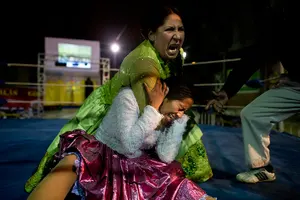Lucha Libre – Bolivian Wrestling

January 27, 2023
Whenever someone asks me which sport I play and I answer wrestling, I always get the most interesting reactions. Some people stare at me in amazement and shock while others ask me questions in curiosity. How can a 4 foot 11 girl that’s built like a twig do wrestling? Wouldn’t she get crushed? Isn’t wrestling mostly for boys?
That last question always gets me thinking. How come everyone keeps asking me that? Why is women wrestling so shocking to some people? Is there a form of wrestling where it’s mostly women that do it?
That’s when I started doing my research. I came across a video and a few articles, all about the same thing, Bolivian Wrestling, also known as Lucha Libre.
Lucha Libre is a different form of wrestling that is both a form of entertainment and a way to show what women are able to do. The sport traces its roots in Mexican professional wrestling, and professional wrestling in the U.S. before that. When wrestling, the women wear long traditional layered skirts called Polleras that they swirl to Cumbia music once they enter the ring.
In Bolivian wrestling, the wrestlers have to be good actors and athletes. The sport is less about the competition and more about the theater. It’s like a story. They either play good or evil characters. “Rudas”, meaning the equivalent heels in English, are the evil characters. Sometimes, they either shake a 2-liter soda bottle and spray its contents into the audience, sneer, or hurl insults at the crowd. “Tecnicas” are good characters. They stand with a microphone in the ring and announce their loyalty to “the people” and promise to fight for their honor. At the start of the matches, the wrestlers often entertain the audience by using humor such as pulling each other’s braids, or even ripping off the pants of the male opponent to reveal pink boxer briefs. Once they start fighting, the audience yells and cheers for the Tecnica to win and beat the Ruda.
Although this sport is beloved by most Bolivians, Chauvinism is one of their biggest problems. Chauvinism is the belief that men are superior to women, especially in a workplace. Martha La Alteña, a very popular wrestler in Bolivia, has expressed in the past that some of the men in Bolivia who are against female Bolivian wrestlers have a problem with them because they wear traditional clothes even though they wear them every day. La Alteña also says Bolivian men “are starting to realize that women are their equals.”
But even with some of the men set against women wrestling, others including both men and other women are supportive. “I absolutely love the crowd,” La Alteña says. “They are vital for the sport. On Sundays when we fight, there will often be older ladies in the crowd who cheer so loudly, they shout ‘hit her, hit her!’ If we fight men they shout ‘abuse’ at the men or throw things at them.”
Due to this sport, women are starting to feel like they can do more than just be housewives or street vendors. Thinking about what the Latin American women have accomplished in wrestling, makes me feel more motivated to compete in this sport.
